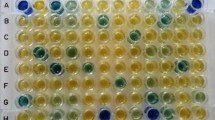Summary
Isoelectric focusing (IEF) was investigated as an aid to the identification of Leptosphaeria narmari, a fungus thought to be the main causal organism in New South Wales of the turf disease commonly referred to as spring dead spot. Cultures of this fungus do not fruit on agar media so positive identification of cultures by taxonomic features of pseudothecia is impossible.
Extracts obtained from fungal colonies grown in nutrient broth were separated by IEF, pH range 4.0 – 6.5. The protein banding patterns detected by staining with Serva Blue clearly differentiated Leptosphaeria narmari, L. korrae and L. maculans. Sixteen isolates from turf with spring dead spot from New South Wales and South Australia were also compared by IEF. All isolates, except two, had a similar pattern of protein bands to an authentic isolate of L. narmari.
Similar content being viewed by others
References
Bailey J.L. (1967) — Techniques in protein chemistry. 2nd Ed. Elsevier, Amsterdam.
Clare B.G. & Zentmyer G.A. (1966) — Starch gel electrophoresis of proteins from species of Phytophthora. Phytopathology, 56: 1334–1335.
Endo R.M. (1985) — Leptosphaeria korrae, a cause of the spring dead spot disease of bermudagrass in California. Plant Disease, 69 (3): 235–237.
Gabriel D.W. & Ellingboe A.H. (1982) — Polypeptide mapping by two-dimensional electrophoresis and pathogenic variation in field isolates and inducted mutants of Erysiphe graminis fsp. tritici. Phytopathology, 72: 1496–1499.
Hall R., Zentmyer G.A. & Erwin (1969) — Approach to taxonomy of Phytophthora through acrylamide gel-electrophoresis of proteins. Phytopathology 59: 770–774.
Lowry O.H., Rosebrough N.J., Farr A.L. & Randall R.J. (1951) — Protein measurement with the Folin phenol reagent. Journal of Biological Chemistry, 193: 265–275.
Moline H.E., Johnson K.S. & Anderson J.D. (1983) — Evaluation of two-dimensional polyacrylamide gel electrophoresis of acidic proteins of ribosome preparations for identifying plant pathogenic soft-rotting bacteria. Phytopathology, 73:224–227.
Reynolds M., Weinhold A.R. & Morris T.J. (1983) — Comparison of anastomosis groups of Rhizoctonia solani by polyacrylamidegel electrophoresis of soluble proteins. American Phytopathological Society, 73 (6): 903–906.
Righette P.G. & Bosisio A.B. (1981) — Applications of isoeiectric focusing to the analysis of plant and food proteins. Electrophoresis, 2: 65–75.
Smith A.M. (1967) — Spring dead spot of couch grass turf in New South Wales. M.Sc.Agr. Thesis, University of Sydney.
Smith A.M. (1971) — Spring dead spot of couch grass turf in New South Wales. Journal of the Sports Turf Research Institutes, 47: 54–59.
Snider R.D. & Kramer C.L. (1974) — An electrophoretic protein analysis and numerical taxonomic study of the genus Taphrina. Mycologia, 66: 754–772.
Walker J. & Smith A.M. (1972) — Leptosphaeria narmari sp. nov. and L. korrae sp. nov., two long-spored pathogens of grasses in Australia. Transactions of the British Mycological Society, 58 (3): 459–466.
Willetts H.J., Byrde R.J.W., Fielding A.H. & Wong A-L. (1977) — The taxonomy of the brown rot fungi, Monilinia spp., related to their extraceliuiar cell wall degrading enzymes. Journal of General Microbiology, 103 (1): 77–84.
Author information
Authors and Affiliations
Rights and permissions
About this article
Cite this article
Hawkes, N.J., Harding, H.W.J. Isoelectric focusing as an aid to the identification of Leptosphaeria narmari, A cause of spring dead spot in turf. Australasian Plant Pathology 14, 72–76 (1985). https://doi.org/10.1071/APP9850072
Issue Date:
DOI: https://doi.org/10.1071/APP9850072




